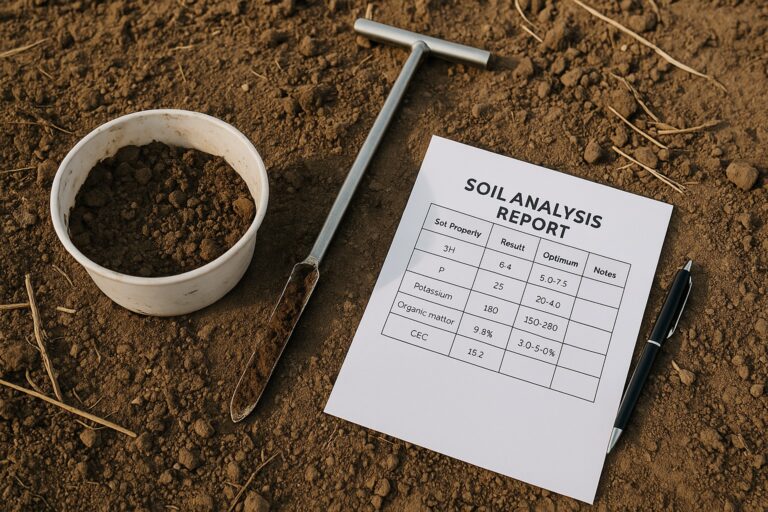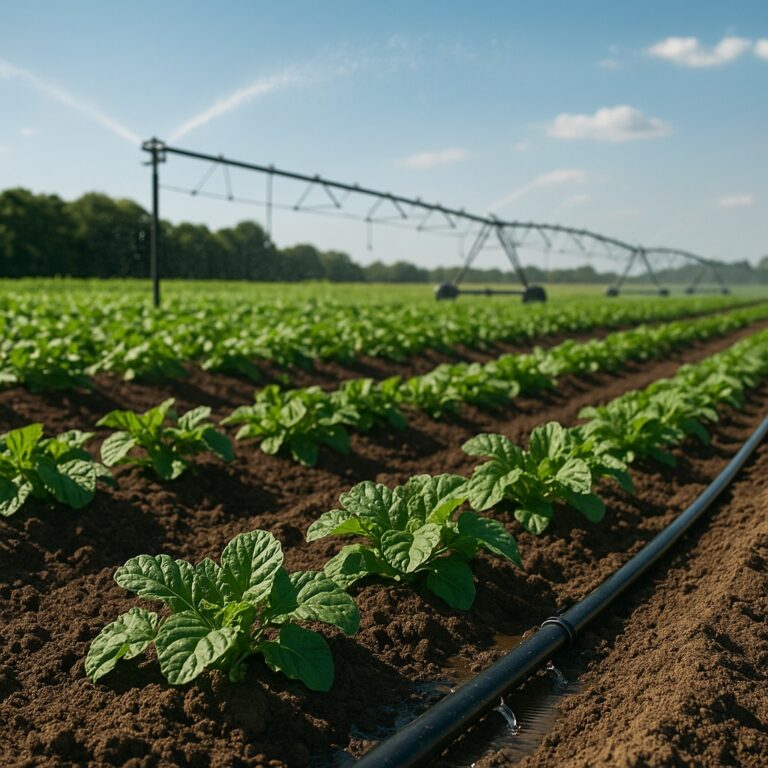Anúncios
In modern agriculture, sustainability is not just a trend—it’s a necessity. One of the most effective ways to improve soil health, manage pests naturally, and enhance crop productivity is through the use of cover crops. While they’ve been used for centuries, cover crops have recently gained new attention among producers looking to reduce inputs and build more resilient farms.
Small and medium-sized farmers across the United States are discovering the long-term value of integrating cover crops into their operations. Whether the goal is to reduce erosion, increase organic matter, suppress weeds, or fix nitrogen, the right choice of cover crop can make a meaningful difference.
This article will guide you through the key benefits of cover crops, how they work, and how to choose the best option for your farm. If you’re aiming for a more productive, cost-efficient, and environmentally responsible operation, this guide was written with you in mind—read on to gain clear, actionable insights.
What are cover crops?
Cover crops are plants grown primarily not for harvest, but to benefit the soil and overall health of the farm ecosystem. Unlike cash crops, they are typically planted between main crop cycles or alongside them, with the purpose of covering the soil. Common types include legumes, grasses, brassicas, and broadleaf species.
The role of cover crops goes beyond simply occupying space in the field. They serve as biological tools for improving fertility, managing erosion, increasing biodiversity, and enhancing soil structure. By acting as a living mulch, they provide protection to the soil while contributing to the long-term productivity of the land.
In the United States, cover cropping is increasingly integrated into conservation practices supported by institutions like the USDA’s Natural Resources Conservation Service (NRCS), reinforcing their importance in sustainable farm management.
Key benefits of using cover crops
Cover crops offer multiple agronomic and economic benefits that can be appreciated both in the short and long term. Below are some of the most relevant advantages for small and medium-sized farmers.
1. Soil improvement: Cover crops prevent soil erosion by stabilizing the surface with their root systems. Legumes, for instance, can fix nitrogen in the soil, enriching it naturally.
2. Organic matter increase: As cover crops decompose, they contribute to building organic matter, which improves soil structure, water retention, and microbial life.
3. Weed suppression: Fast-growing species create a dense canopy that reduces the light available to weeds, helping reduce herbicide needs.
4. Pest and disease control: Certain species act as trap crops or disrupt pest lifecycles. Additionally, increased biodiversity can lead to a more balanced ecosystem with natural pest predators.
5. Moisture retention: By shading the soil and reducing evaporation, cover crops help retain valuable moisture, especially important in drought-prone areas.
6. Nutrient cycling: Deep-rooted cover crops can pull up nutrients from deeper soil layers, making them more accessible for future cash crops.
7. Reduced compaction: Species like radish can break up compacted layers, enhancing root penetration and improving water infiltration.
These benefits combined lead to more resilient farms, better yields over time, and reduced dependence on synthetic inputs.
Types of cover crops and their functions
Different cover crop species offer different benefits. Choosing the right one depends on your farming goals and local conditions. Here’s an overview of the main types:
1. Legumes (e.g., clover, vetch, cowpeas): Excellent for fixing atmospheric nitrogen into the soil, reducing the need for nitrogen fertilizers. Useful in rotations with high-demand crops like corn.
2. Grasses (e.g., rye, oats, barley): Ideal for erosion control and organic matter addition. Their fibrous root systems are particularly effective at stabilizing soil.
3. Brassicas (e.g., radish, mustard, turnip): Known for breaking compacted soils and reducing nematode populations. Their rapid biomass production is a bonus for weed suppression.
4. Broadleaf species (e.g., buckwheat): Great for pollinator attraction and quick coverage. Often used in summer plantings or as smother crops.
5. Mixes and blends: Combining species can maximize benefits—like mixing rye (weed suppression and biomass) with vetch (nitrogen fixation). These are especially effective in complex rotations.
Each type has a unique window of effectiveness, seeding rate, and termination strategy, so careful planning is crucial.
How to choose the right cover crop for your farm
Selecting the most suitable cover crop starts by identifying your primary goal. Ask yourself the following:
- Do you need to improve nitrogen levels in your soil?
- Are you looking to reduce erosion on sloped fields?
- Is weed pressure a major concern?
- Are you dealing with soil compaction?
Once your objective is clear, evaluate the following factors:
1. Climate and region: Cool-season crops like rye and clover work well in northern states, while cowpeas and sorghum-sudangrass are better suited for southern climates.
2. Soil type: Sandy soils may benefit from fibrous-rooted grasses, while heavier soils may be better served by brassicas that penetrate compaction.
3. Crop rotation: Choose a species that doesn’t belong to the same family as your cash crop to avoid disease carryover. For instance, avoid using brassicas if your main crop is also a brassica (like canola).
4. Equipment and management capacity: Consider the tools you have for planting and terminating cover crops. Some species require specific equipment for mowing, rolling, or herbicide application.
5. Timing and seeding window: Align the seeding of your cover crop with harvest times and planting dates of your main crop. Late-fall plantings require cold-tolerant species.
By matching these conditions to the traits of different species, you’ll select a cover crop that delivers maximum return on effort and investment.
Step-by-step guide to implementing cover crops
Implementing cover crops involves a series of steps that should be integrated into your cropping plan. Here’s how to get started:
Step 1: Define your objective
Clarify whether your main goal is nutrient management, erosion control, weed suppression, or another benefit.
Step 2: Choose the appropriate species
Based on your goal and local conditions, select a cover crop or mix of species.
Step 3: Determine seeding method
You can broadcast seed, use a no-till drill, or interseed into standing crops. Choose based on the level of soil disturbance you allow.
Step 4: Prepare the seedbed
Ensure proper seed-to-soil contact. If seeding after harvest, minimal soil prep may be needed. For summer plantings, tillage may be required.
Step 5: Plant at the right time
Follow regional planting calendars to ensure adequate growth before winter or before the next main crop.
Step 6: Monitor growth and adjust
Watch for pest pressure, nutrient deficiencies, and weed escape. Adjust irrigation and fertility as needed.
Step 7: Terminate the crop properly
Terminate using mowing, herbicide, winterkill, or rolling/crimping, depending on species and planting schedule. Timing is critical to avoid interference with your main crop.
Step 8: Evaluate results
Keep records of soil improvements, input savings, and crop performance. This feedback loop will guide better choices in the next season.
Mistakes to avoid when using cover crops
While cover crops offer many benefits, mismanagement can lead to frustration or even losses. Here are some common mistakes to avoid:
1. Planting too late or too early
Improper timing can result in poor establishment or excessive growth that’s hard to manage.
2. Choosing the wrong species
Some cover crops might compete with your cash crop, host diseases, or fail to survive in your climate.
3. Ignoring termination timing
Letting a cover crop grow too long can delay planting or require additional passes to manage.
4. Not adjusting nutrient management
Legumes, for example, contribute nitrogen—you may need to reduce synthetic fertilizers accordingly.
5. Skipping weed scouting
Cover crops are not a silver bullet. You still need to scout for weeds and act if pressure builds.
6. Poor planning for the next crop
Always think ahead—some cover crops may deplete moisture or release allelopathic compounds that affect germination of the next crop.
Avoiding these pitfalls ensures that your investment in cover crops pays off sustainably and consistently.
Economic impact and return on investment
While there is an upfront cost to seed, labor, and management, cover crops can save money over time. Here’s how they contribute financially:
- Reduced fertilizer needs: Especially when using legumes.
- Lower herbicide use: Due to weed suppression.
- Fewer erosion-related losses: Protecting topsoil helps maintain productivity.
- Improved yields: Healthier soils often lead to more consistent crop performance.
- Incentive programs: The USDA and other organizations offer cost-share programs to support cover crop adoption.
A study by the SARE program (Sustainable Agriculture Research and Education) found that after just three years, many farmers experienced a positive net return, especially when yield improvements were considered.
The long-term value of cover crops becomes more evident when combined with other regenerative practices like reduced tillage, diversified rotations, and composting.
Final considerations
Cover crops are not a one-size-fits-all solution. They are tools—versatile and powerful—but they require planning, observation, and adaptation. For small and medium-sized producers looking to improve soil health, reduce dependence on chemicals, and future-proof their operations, cover crops offer a solid path forward.
As more farmers adopt these strategies, knowledge-sharing and local experimentation will continue to shape best practices. Start small, learn from each season, and keep building a system that supports both your productivity and the health of your land.
FAQ
1. How long does it take to see results from cover crops?
Many benefits, such as weed suppression and erosion control, can be observed in the first season. Improvements in organic matter and soil structure may take multiple years.
2. Do cover crops require irrigation?
In most cases, cover crops rely on natural rainfall. However, in arid regions, supplemental irrigation may be needed for establishment.
3. Can I graze livestock on cover crops?
Yes, certain species are excellent for grazing and provide dual benefits of soil improvement and livestock feed. Just ensure proper rotational timing.
4. Are there government programs to help cover costs?
Yes. The USDA NRCS offers financial assistance through programs like EQIP and CSP. Check your local office for eligibility.
5. What’s the best cover crop for a beginner?
Cereal rye is a common starter crop due to its ease of establishment, hardiness, and broad benefits. Pairing it with a legume can provide even greater results.



